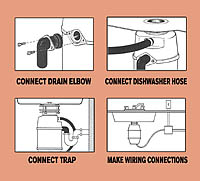
It's definition time again. Alternately called by such names as “disposer,” “garbage disposer,” “garbage grinder,” “disposall,” and “food waste disposer,” the product we're discussing here is installed in the drain outlet of the kitchen sink for the purpose of grinding up garbage and flushing it down the drain. (Technically, the term “Disposall,” a trademark of the General Electric Co., is not intended as a generic identification of all such products.) The terms most commonly used by the companies making these products are “garbage disposer” and “food waste disposer.” From the standpoint of relating the name to its function, the latter term is probably one of the better choices.
To some people, the word “garbage” can mean just about anything you would otherwise toss in the garbage can, including paper, glass, string, metal and plastic objects - materials not meant to go into a disposer. While a good disposer can do an amazing job on most food wastes, these other materials can do an “amazing job” on a disposer.
How They Work
It's surprising how many industry people really don't comprehend the workings of a disposer. In reality, what happens down in that “dark hole” is really not that mysterious. When garbage is pushed down into the grind chamber, it falls onto a rapidly spinning turntable that flings it by centrifugal force against a series of cutting teeth around the perimeter. Spinning the garbage against these teeth (technically called the grind ring or shredder ring) causes a grating action that reduces the waste into particles about the size of rice grains. The ground particles then pass between the grind ring teeth to the chamber below, where they are flushed (by water running through the disposer during use) through the disposer outlet and into the drain system. This flushing is important to prevent a buildup of residue in the disposer's lower chamber, as well as in the smaller diameter portions of the connecting drain line. That's really all there is to the mechanical concept of a disposer, and almost every disposer made today works on the same basic principle. When you talk about product features, you're really dealing with refinements and extras added to this basic concept - which brings us to the next part of our discussion.Motor Sizing
In terms of quality, one of the most fundamental criteria concerns the power of the motor provided. As you might expect, low-cost disposers are equipped with the smallest motors; high-grade types use the largest. The most common motor sizes in terms of horsepower are the 1/3 and 1/2 types today, though most manufacturers offer top-of-the-line 3/4 and 1 hp models. (Disposers equipped with the smallest motors are sometimes called “builder models,” since these are commonly used in tract housing and apartment construction.) It is important to understand that increased horsepower provides an advantage in terms of increased torque, not necessarily related to speed. The key benefit of a more powerful motor is that it is less prone to laboring and jamming.Type Of Feed
There are two basic methods of activating a disposer - batch feed and continuous feed. By batch feed, we mean that a load of garbage is inserted into the grind chamber, and the motor is started by placing the stopper down into the mouth of the drain flange. The continuous feed variety is far more common, and is pretty much the standard today. With this type of disposer, you turn the unit on by flipping a remote wall switch before you begin inserting the garbage. Rather than periodically feeding the garbage in batches, you just keep inserting small quantities until it's all gone. From the standpoint of installation, of course, this type is a bit more involved since in-wall wiring must be provided to a switch location. (As an alternative to the wall switch, some manufacturers now offer an “air switch” mounted into the faucet ledge of the sink. This is essentially a pneumatic relay that transfers a column of air to an electrical switch below.)Turntables & Impellers
The component connected directly to the motor shaft is called the turntable. These are the things to be aware of in this area:
1) The material makeup of the parts. Galvanized steel and stainless steel are the most common materials in use, with the latter deemed the higher quality choice because it is more resistant to corrosion and acid attack (typically, it is used on better models).
2) Impellers on a turntable are the lugs located near the edge which assist in keeping the garbage spinning against the grind ring. Without them, there would be a tendency for the garbage to “float” while the turntable continued to spin below the mass. Initially, these were stationary, functionally integral to the turntable. Following this came the development of the current type in which the impellers swivel on bolts or rivets at the turntable's edge. The advantage of this approach is that the impellers, if they are about to enter a jam condition, automatically back off and thus avert the jam.
